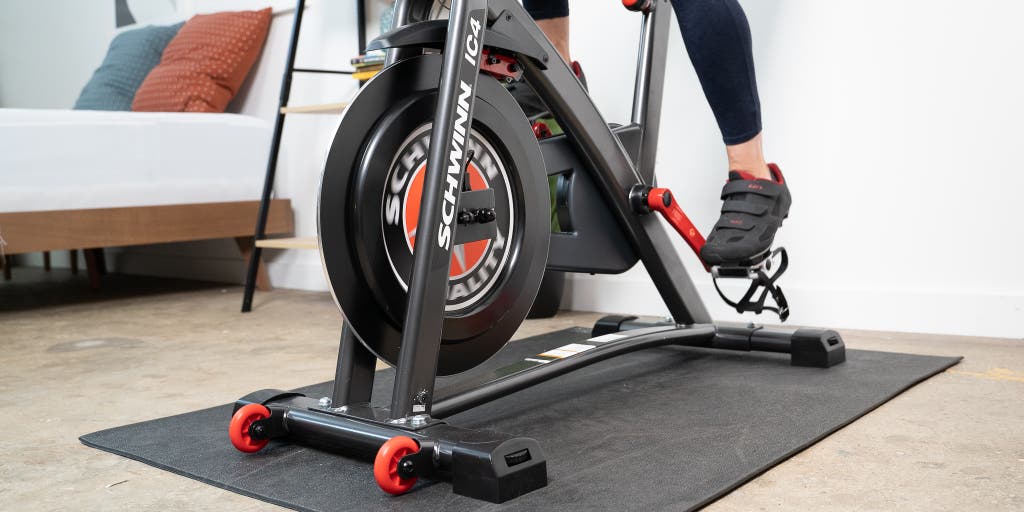How Much Does A Peloton Bike Weigh? Find Out the Weight of Your Favorite Exercise Companion!
The Peloton bike weighs approximately 135 lbs (61 kg). The Peloton bike is designed to provide a challenging workout experience at home, and its weight ensures stability and durability during intense workouts.
With its sleek and compact design, the Peloton bike can easily fit into any home gym or living space. Whether you’re a beginner or an experienced cyclist, the Peloton bike offers a wide range of classes and features to help you achieve your fitness goals.
Enjoy the convenience of working out from the comfort of your own home with the Peloton bike.
Understanding The Weight Of Your Favorite Exercise Companion
How Much Does A Peloton Bike Weight?
Understanding the Weight of Your Favorite Exercise Companion
Introduction to the Peloton Bike
The Peloton Bike has quickly risen to popularity as one of the most sought-after exercise companions in recent years. With its sleek design and impressive features, it has become a staple in many homes and fitness studios alike. But one important aspect that often goes overlooked is its weight. Understanding the weight of the Peloton Bike is crucial for a variety of reasons, including moving and transportation, as well as ensuring the bike can adequately support the user’s weight. In this article, we will delve into the weight of the Peloton Bike and why it is essential to know.
Brief overview of the Peloton Bike
The Peloton Bike is an indoor stationary exercise bike that offers a unique and immersive workout experience. It is equipped with a large HD touchscreen display that streams live and on-demand cycling classes, allowing users to participate in virtual workouts with top instructors. The bike features a sturdy frame, a comfortable seat, and adjustable handlebars, ensuring a comfortable and customized riding experience for users of all fitness levels.
Explain its popularity and features
The Peloton Bike’s popularity can be attributed to a combination of factors. Firstly, its sleek and modern design appeals to fitness enthusiasts who want an exercise machine that seamlessly fits into their home decor. Additionally, the interactive features, such as the live classes and leaderboards, create a sense of community and competition, making each workout session engaging and motivating. The bike also offers a variety of workout options, including cycling, strength training, and yoga, providing users with a comprehensive fitness experience.
Now, let’s talk about the weight of the Peloton Bike.
Importance of knowing its weight
Knowing the weight of the Peloton Bike is crucial for several reasons. Firstly, if you are planning to move or transport the bike, understanding its weight will help you make necessary arrangements, such as ensuring you have appropriate transportation or assistance to handle its size and weight. Additionally, it is important to know the bike’s weight capacity to ensure that it can support your body weight during workouts. The Peloton Bike has a weight limit of 297 lbs (135 kg), and exceeding this limit may compromise its stability and pose safety risks. By knowing the weight of the Peloton Bike, you can make informed decisions about its placement, transportation, and usage to ensure a safe and enjoyable fitness experience.
In conclusion, understanding the weight of your favorite exercise companion, the Peloton Bike, is essential for various reasons, including transportation and weight capacity considerations. By taking the time to familiarize yourself with the bike’s weight and limitations, you can ensure a seamless and safe workout experience.
Why Is The Weight Of A Peloton Bike Important?
The weight of a Peloton Bike plays a crucial role in several aspects, impacting assembly and setup, portability and storage considerations, as well as weight capacity and stability. Understanding the importance of the bike’s weight helps you make an informed decision when purchasing and using this popular indoor exercise equipment.
Impact on Ease of Assembly and Setup
Considering the weight of a Peloton Bike is vital during the assembly process. The weight determines how manageable and straightforward it is to put the bike together, ensuring a seamless setup experience. A lighter bike weight allows for easier handling, reducing the effort required to assemble the components properly.
On the other hand, if the bike is too heavy, it may pose challenges during assembly, potentially requiring additional assistance or tools. It’s important to factor in the weight when considering the ease of setup, as it directly affects the overall user experience and satisfaction.
Portability and Storage Considerations
Another important factor influenced by the weight of a Peloton Bike is its portability and storage options. A lighter bike weight allows for easy maneuverability, making it more convenient to move the bike within your home or transport it if needed. Whether you prefer to change its location or pack it for travel, a lighter bike weight ensures effortless handling.
Conversely, a heavier bike may be more challenging to move around and restricts options for storage. If you have limited space or prefer to store the bike in a specific area, the weight becomes a significant consideration. Choosing a bike with a manageable weight allows for flexibility in storage arrangements.
Weight Capacity and Stability
The weight capacity of the Peloton Bike is an essential aspect to consider, as it directly relates to stability and safety. The bike’s weight capacity indicates the maximum user weight it can support without compromising stability or performance. It is crucial to select a Peloton Bike that can accommodate your weight and ensures optimal stability during your workouts.
A bike that is too light relative to your weight might compromise stability and pose potential safety issues. On the other hand, a bike that is too heavy for your weight capacity might affect performance and overall comfort. Therefore, understanding the weight capacity and selecting a bike accordingly enhances the overall workout experience and guarantees stability.
In conclusion, when it comes to the weight of a Peloton Bike, it is crucial for ease of assembly and setup, portability and storage considerations, as well as weight capacity and stability. By carefully considering these factors, you can choose the right Peloton Bike that meets your needs and enhances your fitness journey.
How Much Does A Peloton Bike Weigh?
If you’re considering purchasing a Peloton Bike or planning to move one, you might be wondering about its weight. The weight of the bike is an important consideration for transportation and stability purposes. In this article, we’ll break down the weight of the Peloton Bike, including the frame, essential components, and the total weight of a fully assembled bike.
The weight of the Peloton Bike frame
The frame is the foundation of any bike, providing strength and stability. The weight of the Peloton Bike frame is approximately 135 lbs. This weight includes the main frame structure, which is made of high-quality materials to ensure durability and support during intense workouts.
Weight of essential components
In addition to the frame, the Peloton Bike is composed of several essential components that contribute to its overall weight. Here’s a breakdown of their individual weights:
| Component | Weight |
|---|---|
| Flywheel | Approximately 37 lbs |
| Seat | Approximately 5 lbs |
| Handlebars | Approximately 5 lbs |
The flywheel is the heaviest component of the Peloton Bike, contributing significantly to its overall weight. It is responsible for simulating the resistance and smooth pedaling feel of outdoor cycling.
Total weight of a fully assembled Peloton Bike
When all the components are assembled together, the total weight of a fully assembled Peloton Bike is approximately 182 lbs. This weight includes the frame, flywheel, seat, and handlebars.
It’s important to note that the weight mentioned here is an average approximation and may vary slightly depending on specific manufacturing variations.
In conclusion, the weight of a Peloton Bike is approximately 135 lbs for the frame alone. When accounting for the addition of essential components, such as the flywheel, seat, and handlebars, the total weight of a fully assembled bike is approximately 182 lbs. This weight ensures stability and durability during your indoor cycling workouts.

Credit: www.garagegymreviews.com
Factors Affecting The Weight Of A Peloton Bike
When it comes to deciding on the perfect exercise bike, weight is an important factor to consider. The weight of a Peloton bike can impact its stability, portability, and overall user experience. Several factors contribute to the weight of a Peloton bike, including the bike model and generation, design changes or materials used, optional accessories and add-ons, and the variation between shipping weight and assembled weight. Let’s dive into each of these factors to better understand how they affect the weight of a Peloton bike.
Bike model and generation
The weight of a Peloton bike can vary based on the model and generation you choose. Different models and generations may have slight differences in construction and materials, which can result in variations in weight. For example, the Peloton Bike+ may have different weight characteristics compared to the original Peloton Bike.
Discuss any weight variations across different bike models and generations
Table: Weight variations across different bike models and generations
| Bike Model | Weight |
|---|---|
| Peloton Bike | 135 lbs |
| Peloton Bike+ | XXX lbs |
Explain potential differences due to design changes or materials used
The weight of a Peloton bike can also be influenced by design changes and the materials used in its construction. For instance, if the newer generation of the bike features a more lightweight frame or components made from lighter materials, it could result in a decrease in overall weight. Conversely, design changes that focus on enhancing durability or stability might increase the weight of the bike.
Optional accessories and add-ons
Many Peloton users choose to personalize their bikes with additional accessories and add-ons. While these accessories can enhance the overall workout experience, they can also contribute to an increase in the bike’s weight. Popular accessories such as tablet holders, weights, or water bottle holders, although small individually, can collectively impact the overall weight of the bike.
Mention the weight implications of popular accessories such as tablet holders, weights, or water bottle holders
If you decide to attach a tablet holder, weights, or a water bottle holder to your Peloton bike, it’s important to note that these additions may increase the overall weight. The weight of each accessory can vary depending on its size and materials. For example, a tablet holder made of metal might weigh more than one made of lightweight plastics.
Shipping weight vs. assembled weight
Lastly, it’s essential to understand the distinction between the shipping weight and the assembled weight of a Peloton bike. The shipping weight refers to the weight of the bike when it is packaged for transportation, whereas the assembled weight is the weight of the bike once it is fully put together and ready for use.
Highlight any differences between the weight of the boxed bike and the weight once it is fully assembled
The weight of a boxed Peloton bike, including the packaging materials, could be different from the weight of the fully assembled bike. Packaging materials, such as foam padding and cardboard, contribute to the shipping weight but are typically removed when assembling the bike. Therefore, the weight of the fully assembled bike may be slightly less than the shipping weight.
Now that you understand the various factors affecting the weight of a Peloton bike, you can make an informed decision when choosing the model, considering optional accessories, and understanding the weight implications during shipping and assembly. Remember to prioritize stability, portability, and your personal preferences when considering the weight of your Peloton bike.
Tips For Moving A Peloton Bike
Safety considerations when moving
Moving a Peloton Bike requires careful consideration of safety measures to ensure a smooth and accident-free transition. By following these important safety tips, you can safeguard yourself and the bike from any potential risks.
Important safety tips
- Always use proper lifting techniques when moving the Peloton Bike. Bend your knees and lift with your legs, keeping your back straight to avoid strain or injury.
- Wear appropriate footwear to maintain a firm grip on the floor surface and prevent slipping.
- Ensure that the path is clear before moving the bike, removing any obstacles or tripping hazards.
- Use caution when maneuvering around corners or tight spaces to maintain control of the bike at all times.
Recommended tools and equipment
Moving the Peloton Bike can be made easier with the use of certain tools and equipment. Here are some suggestions:
| Tool/Equipment | Description |
|---|---|
| Furniture sliders | These sliders can be placed under the bike’s stabilizers, allowing you to easily glide it across the floor without causing damage. |
| Protective covers for floors | Using floor protectors such as mats or padding can prevent scratches or dents on delicate surfaces. |
Step-by-step guide to moving a Peloton Bike
Follow these step-by-step instructions to safely move your Peloton Bike:
- Position yourself behind the bike.
- Grab the back stabilizers with two hands.
- Lift the back of the bike up to tilt it onto its front wheels.
- Carefully push or pull the bike to its new location, keeping a firm grip on the handlebars.
Remember to take breaks if needed and never attempt to move the bike alone if it exceeds your lifting capacity. Seek assistance from a friend or professional if necessary.
Frequently Asked Questions Of How Much Does A Peloton Bike Weight?
Is The Peloton Heavy To Move?
The Peloton Bike is heavy to move. To move it, grab the back stabilizers and lift the back of the Bike up to tilt it onto its front wheels. Then, carefully push or pull the Bike to its new location.
How Heavy Is Peloton Bike Box?
The Peloton Bike box weighs approximately 135 lbs.
How Do I Move My Peloton Bike To Another House?
To move your Peloton Bike to another house, follow these steps: 1. Position yourself behind the Bike/Bike+ 2. Grab the back stabilizers with two hands 3. Lift the back of the Bike/Bike+ to tilt it onto its front wheels 4. Carefully push or pull the Bike to its new location.
Remember, the Peloton Bike has two wheels on the front stabilizers to make moving easier.
What Is The Light Weight Of A Peloton?
The weight of a Peloton bike is approximately 135 lbs.
Conclusion
To summarize, the weight of a Peloton bike is approximately 135 lbs. This weight makes it sturdy and stable during intense workouts and ensures durability. Whether you’re moving houses or simply rearranging your workout area, the Peloton bike is designed with wheels on the front stabilizers, making it easier to move around.
It’s important to note that the weight limit on a Peloton bike is 297 lbs, providing support for a wide range of individuals. Overall, the Peloton bike offers a high-quality exercise experience with its impressive weight and design.







